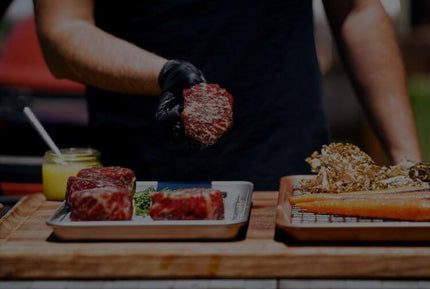

FROM RANCH TO TABLE
SRF BLOG
Shrimp Louie Salad
By: Snake River Farms
One-Pot Saffron Cream Shrimp and Spicy Sausage
By: Snake River Farms
Grilled Shrimp Scampi with Pasta
By: Snake River Farms
Crispy Buffalo Shrimp
By: Snake River Farms
Aguachile de Camaron (Shrimp)
By: Snake River Farms
Open-Faced Lobster Roll with Orange-Chive Crème Fraiche and Caviar
By: Snake River Farms
Scallop and Corn Tacos
By: Snake River Farms
Hot Honey Salt Block Scallops
By: Snake River Farms
Salmon en Papillote
By: Snake River Farms
Mediterranean Salmon Bowl
By: Snake River Farms
Honey Garlic Glazed Salmon
By: Snake River Farms
Maple Brined Coho Salmon and Soft Scrambled Eggs
By: Snake River Farms
Herby Panko-Crusted Halibut with Garlic Truffle Cream Sauce
By: Snake River Farms
Pan Seared Halibut with Lemon-Caper Butter
By: Snake River Farms
Recipes
Pan Seared Halibut with Lemon-Caper Butter
By: Mandy Tanner
Indulge in this delicious pan-seared halibut, perfectly crisp on the outside and tender inside. Drizzled with a zesty lemon caper butter, this dish is a delightful balance of flavors, making it a perfect choice for any occasion. Quick to prepare, it elevates a simple dinner into a gourmet experience!
Read More
Halibut Tacos with Citrus Slaw
By: Snake River Farms
Halibut and Chips
By: Snake River Farms
The Cut: Sirloin
By: Snake River Farms
The Cut: Sirloin
By: Snake River Farms
Unlock the savory secrets of sirloin with Snake River Farms. Premium beef, direct to your door. Explore now!
Read More
Valentine's Guide
By: Snake River Farms
Stories
Valentine's Guide
By: Snake River Farms
Make this Valentine's Day unforgettable with Snake River Farms' guide to crafting the perfect romantic meal. Discover tips, recipes, and gift ideas to impress your loved one.
Read More
Fast Weeknight Meals
By: Snake River Farms
Cooking Guides
Fast Weeknight Meals
By: Snake River Farms
Looking for fast, flavorful meals that fit into your busy schedule? This collection of quick recipes is designed to help you whip up delicious dinners with minimal effort.
Read More
Home for the Holidays - Chef's Version
By: Snake River Farms
Stories
Home for the Holidays - Chef's Version
By: Snake River Farms
Embrace the holiday spirit with Snake River Farms' Chef's Version of 'Home for the Holidays.' Explore comforting classics crafted by culinary experts. From cherished traditions to delightful surprises, discover a medley of heartwarming dishes that bring joy to your festive table. Experience the magic of the season with our curated collection of delicious culinary creations.
Read More
In the Backyard with RJL
By: Snake River Farms
Stories
In the Backyard with RJL
By: Robert Jacob Lerma
RJL is a member of Team SRF and is a Brand Ambassador for GORUCK, Hedley and Bennett, Halo Products, Lynx Grills, Fogo Charcoal and Iowa BBQ Store. His photography clients include YETI, Drew Estate and Patron. His images have been featured in numerous publications including National Geographic, NYTimes, Esquire, Forbes, Food & Wine, Bon Appétit and Outside.
Read More
Dynamic Holiday Duo
By: Snake River Farms
Cooking Guides
Dynamic Holiday Duo
By: Snake River Farms
It’s (much) easier than you think to add a little surf to your turf this season. Photographer and Instagram influencer Chad Montano has the perfect way to elevate your holiday meal in less than five minutes: JUST ADD SEAFOOD.
"The seafood Snake River Farms is sourcing is all really good," Chad says.
Whether you choose a surf-and-turf box of filets mignons, ribeyes, and seafood, or pick a standalone fish or shellfish delivery that can be added to any meal, SRF seafood unlocks a new level of flavor. “The classic is lobster tail and filet mignon because they go together really well,” he says. “Even though filets are lean, you still get a very rich texture from them. And when they’re cooked right, they’re mouthwatering with a nice crust and perfectly medium rare inside. “That’s amazing,” he says. “But when paired with seafood, your taste buds go wild.” SRF seafood amplifies meals with great texture, sweetness, and fresh flavors, Chad says, and they’re versatile enough to fit any menu or cooking style. As an avid griller from Southern California, where it’s almost never a bad day to cook outside, he’s adept at preparing seafood hot and fast over an open flame. It’s easy to cook shrimp, scallops, or lobster tails while your beef is resting. Shrimp and scallops cook in under five minutes and you can judge their doneness by sight. But for lobster, Chad recommends pulling out a quick-read thermometer, like the Thermoworks Super-Fast Pocket Thermometer, to test the internal temperature. He swears by 140°F. “That’s been the sweet spot for me,” he says. “Usually people recommend cooking to 145°F, but carry-over cooking after you pull it off the heat will bring it up to that temperature. At 140°F, it’s perfect — nice and succulent and not chewy or overcooked.” If you’re not blessed with sunny San Diego weather, it’s just as easy to get perfect results with a cast iron skillet and a stovetop. “I really like scallops cooked in a pan with a little bit of oil to get a hard sear, and once they’re flipped, maybe a little bit of butter or some aromatics, and that’s it,” Chad says. However you choose to bring seafood to your holiday table this year, Chad says it will make your gathering just a little more special without a lot of fuss. “It’s so good, and so simple, and you really don’t need to do much to let the flavors shine through,” he says.
Read More
Try a Little Tenderness
By: Dave Yasuda
Try a Little Tenderness
By: Dave Yasuda
With an SRF American Wagyu tenderloin roast, you can bring that daydream into real life. We use the same cut for both our tenderloin roast and our top-selling filets mignons; the full beef tenderloin has a distinctive narrow shape and the power to make any holiday meal deluxe and delicious.
Read More

























